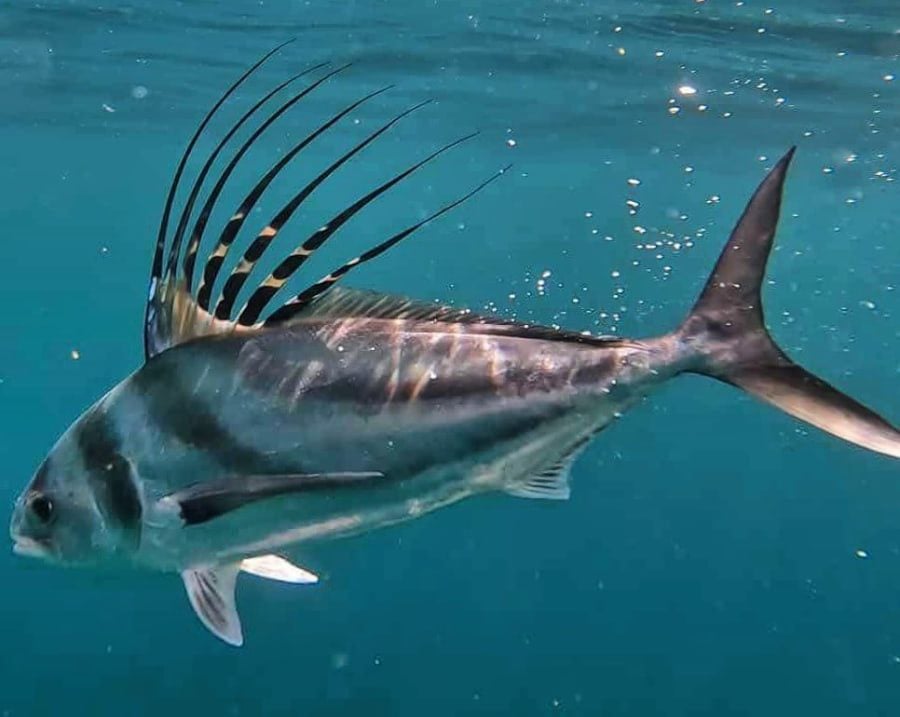Roosterfish, Sí!

Image by Lasse Elmgren
“Just bring a tee shirt and fly rod.” Greg Flores had called from his suite at the Las Palmas Hotel. “These roosterfish are monsters. I see their backs during my morning jog. They look like pigs rooting for corncobs.”
You can tell Greg grew up in the Midwest. His father is Mexican, though, and with his flawless Spanish and green-eyed charm he makes his living selling high-end tequila to nightclubs from Seattle to Caracas. “The last rep didn’t last a year,” he told me. I could guess why.
It was February. I had a few spare days and grabbed a flight to Mexico’s Cabo San Lucas, at the tip of the Baja Peninsula, with that famous spread of gleaming resorts overlooking the Pacific. The typical drinking and clubbing tourists fill the beaches, but heading north development thins and the surf stretches along a wilderness of untouched beaches. Here a handful of devoted fly fishermen chase Baja’s gaudy roosterfish.
And chase is the key word.
This is because the roosterfish, which looks like a dorado crossed with a cock pheasant, seldom stays in one place long. Beach-fishing requires good eyes and better legs. I packed a ten-weight rod and brought a tee shirt, cargo shorts, Converse sneakers, and that’s all. Heck, this is Mexico.
Greg was off God knows where selling tequila, and I had his place to myself. I also had his orange Jeep, and sans top or doors headed out the next morning. Before long I stood on a wide, abandoned beach, the surf low, the bay protected by a great rocky headland. Two foot waves rolled along the white sand.
I really expected little. Greg Flores tends to exaggerate. Sometimes I think he just wants someone to stop by so he can speak some English. I had no illusions about seeing, much less hooking anything.
I saw my first rooster at eight a.m.
My fingers shook as I snaked line through the guides of my fly rod. A long spiked dorsal waved from the shallow surf. I didn’t get within a hundred yards before it vanished. Waiting, scanning the surf, I realized it was just me again, and a whole lot of ocean.
I got back in the Jeep. There was a gravel road, really just tread marks, and I drove along eyeballing the sea. I passed two men sitting under palm trees, their pangas beached. Pangas are long, white, open boats, powered by big outboards. I stopped and asked in bad Spanish if they had seen any fish.
“Roosterfish, sí!” one of them said.
Good enough for me.
A quarter mile later I caught the V-shaped disturbance that indicates action. This time I made sure I approached more carefully, getting into the water like a trout angler and wading in the canvas sneakers. Incoming waves splashed my knees. There they were. I watched two big roosterfish coast in with the surf, working rocks for baitfish. I false cast a four-inch, pink clouser once, twice, the third time nearly hitting one on the head. He turned away, but I was in range.
This time I let the fly drop six feet in front of the cruising fish. The closest turned and ran away. As I swore the bigger of the two turned back and with a lightening surge took my fly.
What’s it like to tie line to a Labrador Retriever? Then throw a tennis ball? I was about to find out.
The reel screamed, and my thumb took a painful crack from the handle. The roosterfish went out with a receding wave, then came back again with the next, fighting the whole way. He nearly beached himself, then turned and headed out to sea. The line looped behind my back and I had one terrifying moment when I thought I would do the same. But I stepped out and the fish shot into deep water.
Now the real fight was on.
Over the next ten minutes I worked the fish, or the fish worked me. He stayed just beyond the breakers, and the waves had picked up with the morning breeze. The rooster quickly took all my fly line and I watched half the backing snap in the surf. I easily had a hundred yards out. That’s a lot of line. It was attached to a lot of fish.
Once past breakers roosterfish stay deep, bulling for the sea bottom. Mine fought against a thirty-pound fluorocarbon leader. When he ran I let him. When he let up he had all that line dragging behind.
Finally I felt him coming in, and reeled like mad. There were a couple more heart-stopping runs, but I gained line every time. At last he washed up on the beach like a dead swimmer. I thought I killed him, but they leave all their fight in the ocean. When I hoisted him up by that narrow, deeply-forked tail he kicked, and I knew he’d make it. And I had my roosterfish.
I like to think he went forty pounds. Of course I’d like to think he went fifty. Another gringo wandering the beach put him at a conservative thirty. Friends, that’s a lot of roosterfish before breakfast.
It would take as long to revive him as it took to catch him. Finally I released his tail. He wandered a bit, then shot into the surf.
I drove back. I didn’t want to push things, fishing into the middle of the day. Even in winter the Baja sun is punishing.
‘Outside the Las Palmas there is a cantina named Crazy Philbert’s. I ordered the Number One and Number Five breakfast, with a side of refried beans and jalapeños. And a huge glass of ice cold watermelon juice. I must have been quite a sight when Greg Flores found me at the table, wet, sandblown, and surrounded by all that food.
“You caught a roosterfish?” he asked in disbelief.
“Sure did.” I told him about my morning. I’m not sure he believed any of it. A tequila salesman, I imagine, hears a whole lot of stories. We would do a little more fishing together over the next few days. And a little tequila-drinking.
But very little. Greg has a good deal going, and intends to hang around to tell his own stories.











